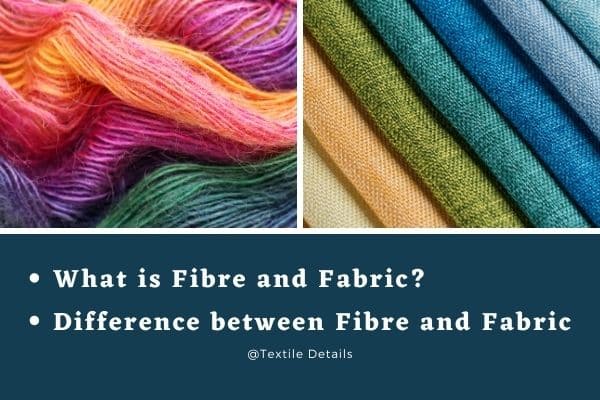What is Fibre?
The material which consists of a fibrous structure and has a length of at the latest 1000 times its diameter is called fibre. Fibre is a thread or filament. Not all fibres are textile fibres. If a textile fibre has a certain amount of elasticity, firmness, and length, we can call it Fibre. In this article we will discuss details about fibre and fabric and then we will go on the complete journey of fiber to fabric.
What is Textile fibre?
The material which consists of a fibrous structure having a length of at least 1000 times its diameter and can be spun into a yarn or made into thread and easily colored are called textile fibre. The fibres have all the qualities of yarn-making that are textile fibres.
Criteria of textile fibre:
- Spin ability or spunable.
- Length to width ratio ( 1000 times greater than width).
- Sufficient Strength.
- Flexibility.
- Dyeing Ability.
- Cohesiveness.
- Ability to resist, and so on.
Classification of Textile fibre

1. Natural fibre:
The fibre is derived directly from nature we can call it natural fibres. Here are some Fibre examples, such as cotton, silk, and flax, which naturally exist in nature in fibrous form. Natural Fibres can be divided into three groups based on a variety of sources. Example as:-
a) Vegetable fibre:
Vegetable fibre is directly derived from natural pure cellulose, which does not require any artificial processing to bring it into Fibre form. The source of this fibre is tree bark, seeds, etc. There are 3 types of vegetable Fibre. The classification of Vegetable fibre are as:
i.Seed fibre: Cotton, Kapok, Coir.
ii. bast fibre: Jute, Flax, Remie.
iii. Leaf fibre: Abaca, Sisal.
b) Animal fibre:
Animal fibre ranks second among natural fibres in terms of usage. Animal fibre contains protein fibre-rich in wool and other fibres—most animal proteins made, Where the protein acts as the central structural unit. Such as: Wool, and Slik.
c) Mineral fibre:
Mineral Fibre produces from various mineral ores for a particular use. The fibres which are formed by spinning or drawing molten mineral is called mineral fibre. Such as asbestos, graphite fibre.
2. Man-Made fibre:
A fibre that doesn’t obtain from nature is called man-made fibre. It does not derive directly from nature. There are two types of synthetic fibres. Types of man-made fibre are as:
a) Re-generated fibre:
Fibre from a solution of a natural polymer and having the same chemical constitution as the natural polymer from which the solution was made is called regenerated fibre. Examples include triadacetate, acetate, and viscose rayon.
Two types of re-generated fibre:
- Re-generated Cellulose Fibre
- Re-generated Protein Fibre
b) Synthetic fibre:
The fibre obtained by chemical synthesis is called synthetic fibre. It is produced entirely in the laboratory by chemicals. Therefore there is no saturation of nature. It contains elements like carbon and hydrogen in place of cellulose which means organic compounds are formed in fibre. Example: Nylon, Polyester
There are some more synthetic fibres, such as Rubber, metallic Fibre, minerals, etc.
What is Fabric?
Fabric is the sheet produced from weaving or knitting by spinning yarn obtained in different ways. Such as pulling a series of threads and creating a series of foreign yarns at right angles to each other or by forming loops side by side. The fabric is divided into four parts-
Classification of Fabric
1. Woven fabric:
Manufactured by the interlacement of warp and weft yarn is a woven fabric. Where a bunch of yarn makes these lines producing the warp lines and their interlace along with the ends being laced together at 90 degrees so as to make your woven fabric. Canvas, flannel, georgette, khadi, muslin, Kashmiri, and so on; are examples of woven fabric.
2. Knit fabric:
Manufactured by interloping from a single set of yarn of thread. Knit fabric basically is a string off on it; so looped is a lattice-like structure higher each line or each line of Yarn could be looped together essentially to make your knit fabric. some of the examples of Knit fabric are Lycra Rib, Interlock Fabric, PK or Lacoste, etc.
3. Non-woven fabric:
The fabric is not obtained from weaving or knitting. It’s manufactured by a special kind of chemical or glue mixture. Nonwoven fabrics are manufactured by using heat pressure or moisture on fibres. There’s no grainline on nonwovens. It’s usually more cost-effective to make. But they’re not quite common in clothing. You may usually see them in costumes or other little things as accessories. The best examples of Non-Woven fabrics is Surgical masks, sanitary napkins, baby diapers, coffee bags, and so on.
4. Braided fabric:
Manufactured from more than two fibre. Braiding could be a simple sort of narrow fabric construction. A braid looks like a rope, a thing that’s produced by interweaving three or more yarns. Strips or lengths during a diagonally overlapping pattern. It uses for various industrial applications. It has good elongation characteristics and is very fillable curving around edges nicely. Caps, handbags, lace belts, etc., are examples of braided fabrics.
Difference between fibres and fabrics

Fibres and fabrics are an inseparable part of the textile manufacturing process. Fibre sourced from are natural or synthetic. Usually, fibre is the building block of apparel, which is the smallest unit of fabric. The fibre is a single strand with which yarn produced by spinning the threads together or passing the fibers through spinnerets. Fabric is an organization of single or various fibre. At the point when fibre is weaved, knitted. tied, or sewed together, the design is framed fabric. The fibre and fabric material has used almost everywhere to produce apparel.


I have been absent for some time, but now I remember why I used to love this site. Thank you, I’ll try and check back more frequently. How frequently you update your web site?
You can subscribe via mail or follow us on Google News: https://news.google.com/publications/CAAqBwgKMJPMqwswkNfDAw?hl=en-IN&gl=IN&ceid=IN%3Aen